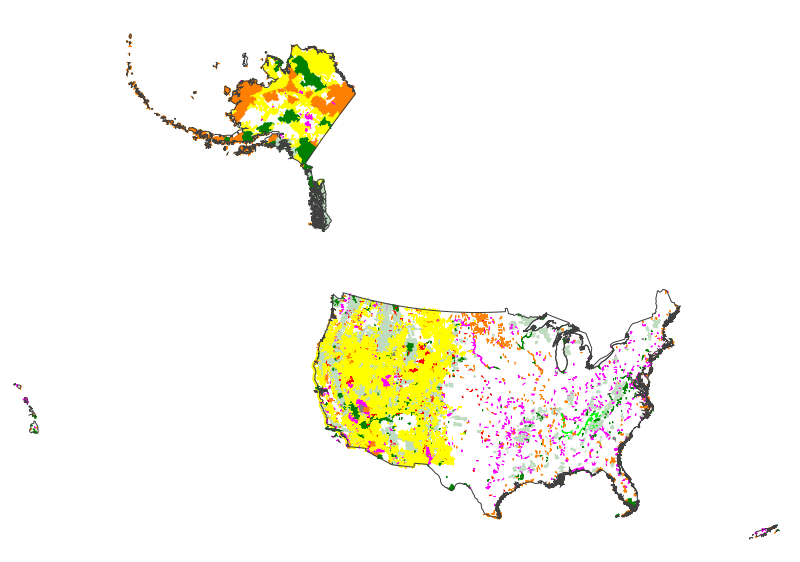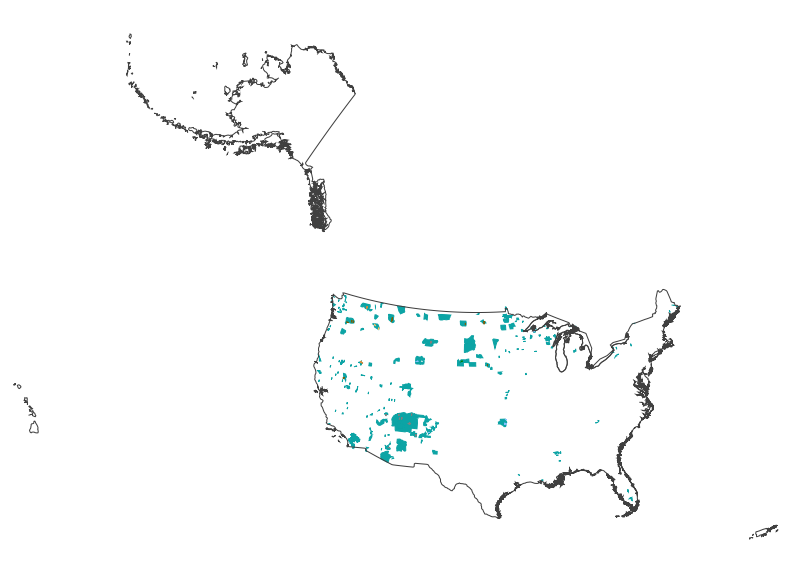Filters: Tags: fish and wildlife service (X)
19 results (51ms)|
Filters
Date Range
Extensions Types Contacts
Categories Tag Types
|

This map layer consists of federally owned or administered lands of the United States, Puerto Rico, and the U.S. Virgin Islands. For the most part, only areas of 320 acres or more are included; some smaller areas deemed to be important or significant are also included. There may be private inholdings within the boundaries of Federal lands in this map layer. Some established Federal lands which are larger than 320 acres are not included in this map layer, because their boundaries were not available from the owning or administering agency.

This map layer shows Indian lands of the United States. For the most part, only areas of 320 acres or more are included; some smaller areas deemed to be important or significant are also included. Federally-administered lands within a reservation are included for continuity; these may or may not be considered part of the reservation and are simply described with their feature type and the administrating Federal agency. Some established Indian lands which are larger than 320 acres are not included in this map layer because their boundaries were not available from the owning or administering agency.
This data layer consists of National Wilderness Preservation System areas in the United States, Puerto Rico, and the U.S. Virgin Islands. The map layer was created by combining the best available data from the federal agency responsible for administration of a given wilderness area. Where larger scale data could not be obtained the National Atlas layer "National Wilderness Preservation System" was used as the data source. In its present form source data varies from a scale of 1:10000 to 1:2,000,000 (see lineage for details on source scale). Additional features have been added by the Environmental Science Division, Argonne National Laboratory based on their work with federal agencies; mainly BLM.
Landscape conservation cooperatives (LCCs) are conservation-science partnerships between the U.S. Fish and Wildlife Service, U.S. Geological Survey (USGS), and other federal agencies, states, tribes, NGOs, universities and stakeholders within a geographically defined area. They inform resource management decisions to address national-scale stressors-including habitat fragmentation, genetic isolation, spread of invasive species, and water scarcity-all of which are accelerated by climate change. LCCs provide scientific and technical support for conservation at "landscape" scales-the entire range of an identified priority species or groups of species. They support biological planning, conservation design,...
Categories: Data;
Types: Downloadable,
Map Service,
OGC WFS Layer,
OGC WMS Layer,
Shapefile;
Tags: Landscape Conservation Cooperatives,
conservation,
fish and wildlife service,
partnerships
This metadata is for the vegetation land-cover and land-use spatial database created at/for Ouray National Wildlife Refuge, Utah.
This metadata is for the vegetation land-cover and land-use spatial database created at/for Lacreek National Wildlife Refuge, Utah
Cover title. "Submitted as a product of the Information and Education Committee of the Recovery Implementation Program for endangered fish of the upper Colorado River Basin.". Shipping list no.: 93-0631-P. "September 1993"--T.p. verso. Includes bibliographical references (p. [61]-63). Published by Fish and Wildlife Service, in 1993.
Categories: Publication;
Types: Book Citation,
Citation;
Tags: Colorado River Watershed (Colo.-Mexico),
Endangered species,
Fish and Wildlife Service,
History,
Rare fishes
This data layer consists of National Wilderness Preservation System areas in the United States, Puerto Rico, and the U.S. Virgin Islands. The map layer was created by combining the best available data from the federal agency responsible for administration of a given wilderness area. Where larger scale data could not be obtained the National Atlas layer "National Wilderness Preservation System" was used as the data source. In its present form source data varies from a scale of 1:10000 to 1:2,000,000 (see lineage for details on source scale). Additional features have been added by the Environmental Science Division, Argonne National Laboratory based on their work with federal agencies; mainly BLM.
This data layer consists of National Wilderness Preservation System areas in the United States, Puerto Rico, and the U.S. Virgin Islands. The map layer was created by combining the best available data from the federal agency responsible for administration of a given wilderness area. Where larger scale data could not be obtained the National Atlas layer "National Wilderness Preservation System" was used as the data source. In its present form source data varies from a scale of 1:10000 to 1:2,000,000 (see lineage for details on source scale).
Merge of: - BLM Wilderness (GSSP, Ilana Cohen) - FS Wilderness (USFS, Tim Love) - NPS Wilderness (PAD-US) - FWS Wilderness (PAD-US)
Types: Downloadable;
Tags: Authorization,
BER,
BLM,
Baseline Environmental Report,
Bureau of Land Management,
The Agassiz Beach Ridges landscape is located in the Red River watershed of northwestern Minnesota and falls and is within the larger Prairie Pothole Region (PPR). The PPR has been identified as being responsible for producing 50–80 percent of the continent’s waterfowl while accounting for only 10% of the available breeding habitat. It is estimated that less than 1% of Minnesota’s historic native prairie remains intact, with much of the remnant prairie scattered about in small clusters. Restoration of key sites within this landscape has been identified as the most important strategy to create a contiguous expanse of prairie/wetland mosaic and improve the ecological functioning of these systems. In the fall of...
Categories: Project;
Types: Map Service,
OGC WFS Layer,
OGC WMS Layer,
OGC WMS Service;
Tags: Birds,
Cropland conversion,
Federally threatened or endangered species,
Fish and Wildlife Service,
Grasses,
Landscape Conservation Cooperatives (LCCs) are public-private partnerships composed of states, tribes, federal agencies, non-governmental organizations, universities, international jurisdictions, and others working together to address landscape and seascape scale conservation issues. LCCs inform resource management decisions to address broad-scale stressors-including habitat fragmentation, genetic isolation, spread of invasive species, and water scarcity-all of which are magnified by a rapidly changing climate. For further information go to https://www.fws.gov/science/catalog. The previous 2011 LCC Network Areas data is available at https://www.sciencebase.gov/catalog/item/52f2735ee4b0a6f0bd498c2f
Categories: Data,
Publication;
Types: ArcGIS Map Package,
ArcGIS REST Map Service,
ArcGIS Service Definition,
Citation,
Downloadable,
Map Service;
Tags: Aleutian and Bering Sea Islands,
Appalachian,
Arctic,
California,
Caribbean,
Landscape Conservation Cooperatives (LCCs) are public-private partnerships composed of states, tribes, federal agencies, non-governmental organizations, universities, international jurisdictions, and others working together to address landscape and seascape scale conservation issues. LCCs inform resource management decisions to address broad-scale stressors-including habitat fragmentation, genetic isolation, spread of invasive species, and water scarcity-all of which are magnified by a rapidly changing climate. For further information go to https://www.fws.gov/science/catalog. The previous 2011 LCC Network Areas data is available at https://www.sciencebase.gov/catalog/item/52f2735ee4b0a6f0bd498c2f
Categories: Data,
Publication;
Types: Citation,
Downloadable,
Map Service,
OGC WFS Layer,
OGC WMS Layer,
Shapefile;
Tags: Aleutian and Bering Sea Islands,
Appalachian,
Arctic,
California,
Caribbean,

This map layer consists of federally owned or administered lands of the United States, Puerto Rico, and the U.S. Virgin Islands. For the most part, only areas of 320 acres or more are included; some smaller areas deemed to be important or significant are also included. There may be private inholdings within the boundaries of Federal lands in this map layer. Some established Federal lands which are larger than 320 acres are not included in this map layer, because their boundaries were not available from the owning or administering agency.
This data set consists of federally owned land polygon features of the United States. The data set was created by extracting federal land polygon features from the individual 1:2,000,000-scale State boundary Digital Line Graph (DLG) files produced by the U.S. Geological Survey. These files were then appended into a single coverage. This is a revised version of the June 1998 data set. There may be private inholdings within the boundaries of Federal Lands in this data set. These data are intended for geographic display and analysis at the national level, and for large regional areas. The data should be displayed and analyzed at scales appropriate for 1:2,000,000-scale data. No responsibility is assumed by the U.S....
Categories: Data;
Types: Downloadable,
Map Service,
OGC WFS Layer,
OGC WMS Layer,
Shapefile;
Tags: Agricultural Research Service,
Army Corps of Engineers,
Federal lands,
Fish and Wildlife Service,
Forest Reserve,
This data set consists of federally owned land polygon features of the United States. The data set was created by extracting federal land polygon features from the individual 1:2,000,000-scale State boundary Digital Line Graph (DLG) files produced by the U.S. Geological Survey. These files were then appended into a single coverage. This is a revised version of the June 1998 data set. There may be private inholdings within the boundaries of Federal Lands in this data set. These data are intended for geographic display and analysis at the national level, and for large regional areas. The data should be displayed and analyzed at scales appropriate for 1:2,000,000-scale data. No responsibility is assumed by the U.S....
Categories: Data;
Types: Downloadable,
Map Service,
OGC WFS Layer,
OGC WMS Layer,
Shapefile;
Tags: Agricultural Research Service,
Bureau of Indian Affairs,
Bureau of Land Management,
Bureau of Reclamation,
Federal lands,

This map layer shows Indian lands of the United States. For the most part, only areas of 320 acres or more are included; some smaller areas deemed to be important or significant are also included. Federally-administered lands within a reservation are included for continuity; these may or may not be considered part of the reservation and are simply described with their feature type and the administrating Federal agency. Some established Indian lands which are larger than 320 acres are not included in this map layer because their boundaries were not available from the owning or administering agency.
This dataset represents the North Atlantic LCC's ecoregion boundary. Landscape conservation cooperatives (LCCs) are conservation-science partnerships between the U.S. Fish and Wildlife Service, U.S. Geological Survey (USGS), and other federal agencies, states, tribes, NGOs, universities and stakeholders within a geographically defined area. They inform resource management decisions to address national-scale stressors-including habitat fragmentation, genetic isolation, spread of invasive species, and water scarcity-all of which are accelerated by climate change.
This data is for planning purposes only. LCCs are applied conservation science partnerships with two main functions. The first is to promote collaboration among their members in defining shared conservation goals. With these goals in mind, partners can identify where and how they will take action, within their own authorities and organizational priorities, to best contribute to the larger conservation effort. The second function of LCCs is to provide the science and technical expertise needed to address the shared priorities and support conservation planning at landscape scales – beyond the scope and authority of any one organization. The organizational model of the LCC Network was intentionally structured to operate...
Categories: Data;
Types: ArcGIS REST Map Service,
ArcGIS Service Definition,
Downloadable,
Map Service;
Tags: Aleutian and Bering Sea Islands,
Appalachian,
Arctic,
California,
Caribbean,
|

|